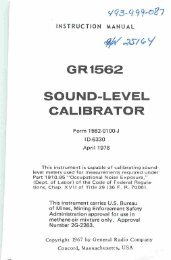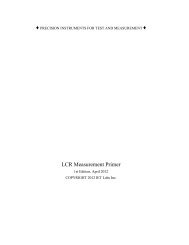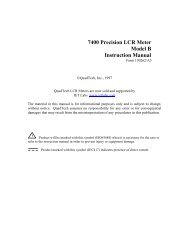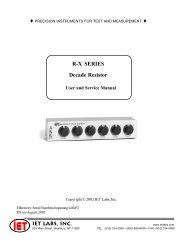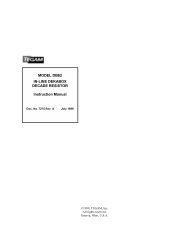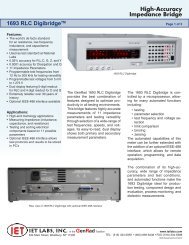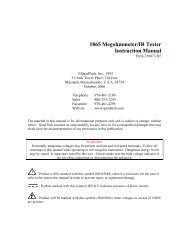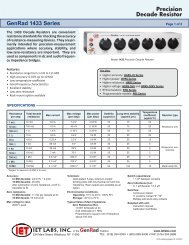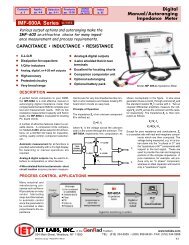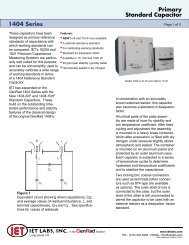Handbook of High Speed Photography - IET Labs, Inc.
Handbook of High Speed Photography - IET Labs, Inc.
Handbook of High Speed Photography - IET Labs, Inc.
Create successful ePaper yourself
Turn your PDF publications into a flip-book with our unique Google optimized e-Paper software.
section 3<br />
GENERAL RADIO<br />
STROBOSCOPES<br />
3.1 THE TYPE 1539STROBOSLAVE® ELECTRONIC STROBOSCOPE.<br />
3.1.1 GENERAL DESCRIPTION. The Type 1539 Stroboslave (Figure<br />
3-1) is a miniature electronic stroboscope. The Stroboslave satisfies<br />
the basic requirements for motion studies and high-speed photography,<br />
but is not suitable for tachometry as it has no internal oscillator. Its<br />
reflector-lamp assembly is connected to the case by a five-foot exten<br />
sion cable so that the lamp can be used either attached to the case or<br />
conveniently positioned over the subject, even in cramped spaces. The<br />
reflector can be removed so that the strobotron lamp assembly can be<br />
inserted through a hole as small as one inch in diameter to observe ob<br />
jects in otherwise inaccessible areas (see Figure 3-2). When the re<br />
flector is in place, the light output is concentrated into a long-throw<br />
10-degree beam (measured at one-half-peak-intensity points) with an<br />
apparent source 18 inches behind the reflector front. For further, more<br />
specific information on the photographic characteristics <strong>of</strong> the 1539 as<br />
a light source with and without reflector, refer to Section 4. The Stro<br />
boslave has the same high maximum flash repetition rate, short flash<br />
duration, and the same light characteristics as the 1531 and 1538 Stro<br />
botac electronic stroboscopes.<br />
3.1.2 TRIGGERING THE STROBOSLAVE. The Stroboslave can be<br />
triggered by the closure <strong>of</strong> a switch across its input terminals or by a<br />
positive voltage pulse <strong>of</strong> at least 2 volts peak amplitude. The Strobo<br />
slave can therefore be triggered by the output pulse <strong>of</strong> the 1538 Strobo<br />
tac, the 1531 Strobotac through a 1531-P4 Trigger Cable, the 1531^P2<br />
Flash Delay, or by the 1537 Photoelectric Pickup. (A table showing<br />
all possible interconnections <strong>of</strong> the various General Radio Stroboscopic<br />
instruments is given in Section 5.) This multiplicity <strong>of</strong> trigger possibil<br />
ities, along with its small size and low cost, make the Stroboslave a<br />
most convenient and economical instrument for a variety <strong>of</strong> applications.<br />
16




